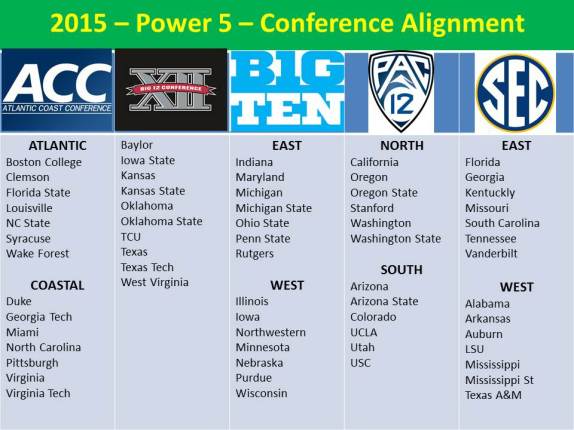Yes, Some Other Dude (SOD) was listening when Jeff Long, Chair of the FBS Playoff Selection Committee kept insisting that the Committee was not in the business of “sending messages” when making their selections, but, I think some messages, intended or not, sublimely or otherwise, were received loud and clear. And, one of the loudest messages SOD heard was, unless you are going to go undefeated, you better have a good out-of-conference schedule to play.
I know that we only have a population of 1 selection process cycle to evaluate and this thing is still morphing, but, it seems to me, that strength of schedule does matter and, especially, the strength or weakness of those out-of-conference games you play.
SOD believes that by going undefeated, ala Florida State this past year, you can overcome a relatively weak schedule, but, once you lose a game, even if the game you lose is to a very good football team, your out-of-conference schedule is going to be scrutinized and have an impact on your ranking. Arguably, both Baylor and TCU are evidence of such in 2014.
Ohio State was, at that time, a controversial pick as the 4th seed in the playoffs, largely based on their “poor loss” to a mediocre Virginia Tech squad. This loss was widely accepted as the worse loss of any team in consideration of a playoff spot. But, how can you fault a team for scheduling, not just a Power 5 opponent, but a Power 5 opponent with a history of being good? Could it be that a loss to a down-year Virginia Tech is less damaging than an out-of-conference schedule made up of SMU, Northwestern State and Buffalo, as in Baylor’s case, or Samford and SMU (I’ll give them Minnesota as being okay) in TCU’s case? Not that OSU’s out of conference schedule of the aforementioned Virginia Tech, Navy, Kent State and Cincinnati was significantly better, but, it at least included all FBS schools.
So, SOD decided to take a look in the future to see if this could possibly be a factor in upcoming seasons. Using FB Schedules.com as my information source, I do see evidence of some tougher schedules ahead, but, I also see some suspect scheduling in the near future that could damage some teams’ chances at one of the four playoff spots in closely contended races.
In particular, Baylor could find themselves in the same predicament with their current future (oximoronic, I know) schedules. Baylor’s 2015 out-of-conference schedule consists of SMU, Lamar and Rice. Really?! The 2016 schedule currently stands as Northwestern State, SMU and Rice. No better. At least in 2017 and 2018 they get Duke on the schedule, but these years also include Liberty and UTSA. And, embarrassingly, Baylor’s 2019 out-of-conference schedule has them playing Incarnate Word, UTSA and Rice! Now, SOD does not know how much flexibility there is to change all of this, but, if Baylor hopes to vie for a spot in any upcoming playoffs, they might want to make some changes.
By comparison, take a look at Big 12 conference rival Texas’s upcoming schedules. Texas is scheduled to play Notre Dame, Rice and California in 2015; Notre Dame, UTEP and California in 2016; Maryland, UCF and USC in 2017; and, Maryland, Tulsa and USC in 2018. Two Power 5 teams and a cupcake each year – MUCH BETTER than 3 cupcakes. Beyond 2018, the incomplete Texas schedules currently include the likes of LSU, Arkansas, Ohio State, and Michigan. Now this is scheduling! And, this is what SOD hopes the Playoff System entices other schools to do, as well.
All in all, there are still many holes to fill in for lots of Power 5 teams; still plenty of time to “toughen” up their schedules; but there are still too many patsies on too many schedules for SOD’s liking. The SEC, as a whole, I think, has a rather soft out-of-conference slate collectively. I think they deserve to do much better if they wish to continue to wave that banner of best conference in the land. Along with Texas, USC’s future schedules look more like that of a team with hopes of great accomplishments. This is the type of scheduling other schools should emulate.
Now. SOD does believe that there is still room for some scheduling creativity or exceptions to the rule. For example, SOD thinks, regardless of what league they are in or how good of a year they are having, scheduling any of the Military Academies should be encouraged and not count against you – just limit it to one a year. SOD also appreciates the value in scheduling regional schools, every now and then. For example, Virginia or Virginia Tech scheduling Old Dominion, William & Mary or Richmond every now and then can be forgiven – just don’t schedule two or more in the same year as Virginia Tech has done for 2018.
And, SOD does understand that schedules are set years in advance and that there is a science to the art of scheduling. It is more than just wanting to toughen up your schedule; it is a matter of availability, timing and coordination. But, SOD does want to see a trending away from so many “easy win” games for teams that have playoff aspirations.
In general, SOD hopes there are more inter-Power 5 games in out-of-conference schedules. If you can’t fill up your schedule with teams from other Power 5 conferences, you should, at least, go for other FBS schools. Although FCS schools do realize branding and financial benefits from games against FBS opponents, SOD wouldn’t mind seeing these games become a thing of the past.
And, there are some changes afoot. The B1G Ten is moving to a 9 game conference schedule in 2016 (same as the Pac-12 has today), resulting in 1 less out-of-conference game for each team. Other conferences may soon follow. Fewer out-of-conference games should result in fewer cupcake games.
Like so many other things in life, we will just have to wait and see. SOD predicts that the future schedules, as they are today, are bound to change, especially those that are 2 or more years out. I certainly hope so. Tougher games in the out-of-conference weeks to start a season should lead to more excitement and provide more common fodder by which to evaluate and rank teams at the end of the season when determining the playoff contenders. No team should be left out of a playoff spot because their schedule was too easy.
What do you think, Baylor and TCU? Regardless, I think the Big 12 having a Championship would also help your cause.

